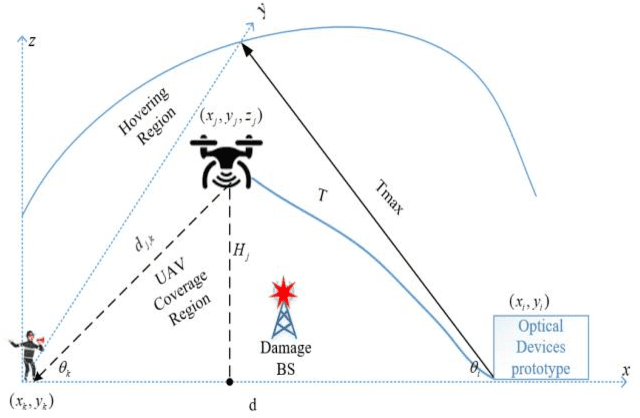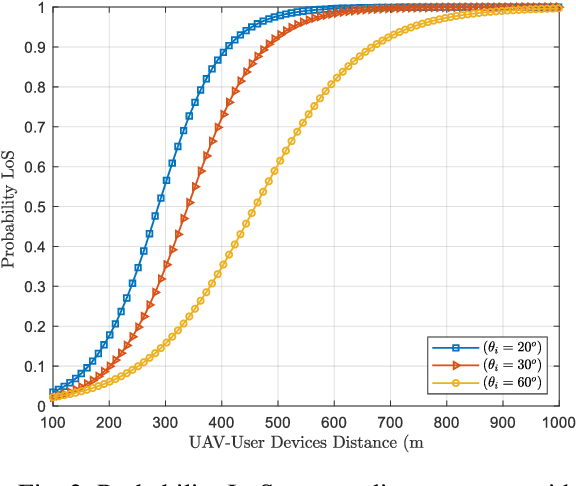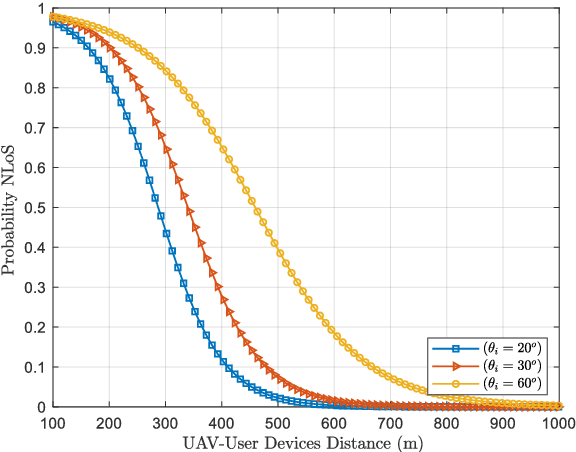S. H. Alsamhi
Energy-Efficient Tethered UAV Deployment in B5G for Smart Environments and Disaster Recovery
Jul 17, 2021



Abstract:Due to Unmanned aerial vehicles (UAVs) limitations in processing power and battery lifetime. The tethered UAV (TUAV) offers an attractive approach to answer these shortcomings. Since a tethered connected to UAV is one potential energy solution to provide a stable power supply that connects to the ground would achieve impressive performances in smart environments and disaster recovery. The proposed solution is intended to provide stable energy and increase the coverage area of TUAV for smart environments and disaster recovery. This paper proposed that the tethered connected to UAV will provide the continuous supply and exchange the data with ground terminals. Besides the adjustable tether length, elevation angels act to increase the hovering region, leading to the scalability of coverage in many applications. Moreover, the power consumption and transmission the distance while achieving a trade-off between the hovering and coverage probabilities. The simulation results demonstrate efficient performance in terms of line-of-sight probability, path loss, and coverage probability for scalability coverage smart environments and disaster recovery scenarios. Furthermore, maximum coverage probability is achieved versus increased tethered length because of the gain and fly over a region of maximum tethered.
Green IoT using UAVs in B5G Networks: A Review of Applications and Strategies
Mar 31, 2021Abstract:Unmanned Aerial Vehicles (UAVs) present a promising advanced technology that can enhance people life quality and smartness of cities dramatically and increase overall economic efficiency. UAVs have attained a significant interest in supporting many applications such as surveillance, agriculture, communication, transportation, pollution monitoring, disaster management, public safety, healthcare, and environmental preservation. Industry 4.0 applications are conceived of intelligent things that can automatically and collaboratively improve beyond 5G (B5G). Therefore, the Internet of Things (IoT) is required to ensure collaboration between the vast multitude of things efficiently anywhere in real-world applications that are monitored in real-time. However, many IoT devices consume a significant amount of energy when transmitting the collected data from surrounding environments. Due to a drone's capability to fly closer to IoT, UAV technology plays a vital role in greening IoT by transmitting collected data to achieve a sustainable, reliable, eco-friendly Industry 4.0. This survey presents an overview of the techniques and strategies proposed recently to achieve green IoT using UAVs infrastructure for a reliable and sustainable smart world. This survey is different from other attempts in terms of concept, focus, and discussion. Finally, various use cases, challenges, and opportunities regarding green IoT using UAVs are presented.
Distributed Clustering for User Devices Under Unmanned Aerial Vehicle Coverage Area during Disaster Recovery
Mar 14, 2021



Abstract:An Unmanned Aerial Vehicle (UAV) is a promising technology for providing wireless coverage to ground user devices. For all the infrastructure communication networks destroyed in disasters, UAVs battery life is challenging during service delivery in a post-disaster scenario. Therefore, selecting cluster heads among user devices plays a vital role in detecting UAV signals and processing data for improving UAV energy efficacy and reliable Connectivity. This paper focuses on the performance evaluation of the clustering approach performance in detecting wireless coverage services with improving energy efficiency. The evaluation performance is a realistic simulation for the ground to air channel Line of Sight (LoS). The results show that the cluster head can effectively link the UAVs and cluster members at minimal energy expenditure. The UAVs altitudes and path loss exponent affected user devices for detecting wireless coverage. Moreover, the bit error rate in the cluster heads is considered for reliable Connectivity in post disaster. Clustering stabilizes the clusters linking the uncovered nodes to the UAV, and its effectiveness in doing so resulted in its ubiquity in emergency communication systems.
Blockchain for Multi-Robot Collaboration to Combat COVID-19 and Future Pandemics
Oct 05, 2020
Abstract:This conceptual paper overviews how blockchain technology is involving the operation of multi-robot collaboration for combating COVID-19 and future pandemics. Robots are a promising technology for providing many tasks such as spraying, disinfection, cleaning, treating, detecting high body temperature/mask absence, and delivering goods and medical supplies experiencing an epidemic COVID-19. For combating COVID-19, many heterogeneous and homogenous robots are required to perform different tasks for supporting different purposes in the quarantine area. Controlling and decentralizing multi-robot play a vital role in combating COVID-19 by reducing human interaction, monitoring, delivering goods. Blockchain technology can manage multi-robot collaboration in a decentralized fashion, improve the interaction among them to exchange information, share representation, share goals, and trust. We highlight the challenges and provide the tactical solutions enabled by integrating blockchain and multi-robot collaboration to combat COVID-19 pandemic. The framework of our conceptual proposed can increase the intelligence, decentralization, and autonomous operations of connected multi-robot collaboration in the blockchain network. We overview blockchain potential benefits to defining a framework of multi-robot collaboration applications to combat COVID-19 epidemics such as monitoring and outdoor and hospital End to End (E2E) delivery systems. Furthermore, we discuss the challenges and opportunities of integrated blockchain, multi-robot collaboration, and the Internet of Things (IoT) for combating COVID-19 and future pandemics.
 Add to Chrome
Add to Chrome Add to Firefox
Add to Firefox Add to Edge
Add to Edge